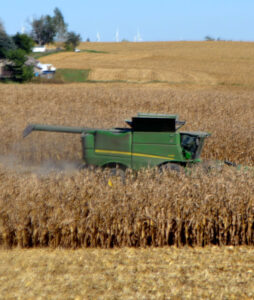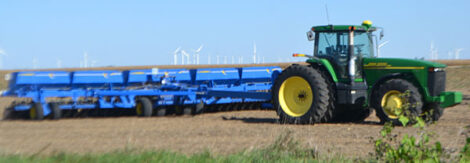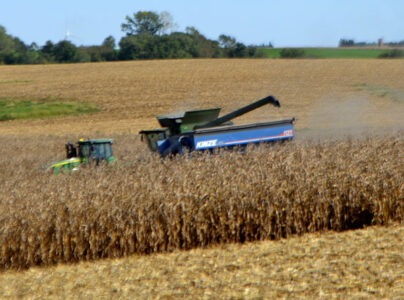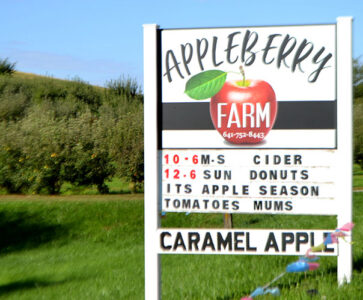Soybeans are ‘in the bin’ while corn harvest is ongoing in Central Iowa
Cost of production outpaces farm income
From apples to corn to soybeans, the fall harvest season becomes a life of its own in central Iowa.
Conversations in coffee shops or at the super table about weather, commodity prices and political decisions made in Washington D.C. can even supersede the achievements or disappointments of local high school athletic teams.
The 2025 harvest season is no different.
Corn and soybeans
Now that soybean harvest is essentially complete, rural landscapes are now dominated by an army of giant combines, wagons and semis fields working in teams to harvest corn.
Craig Pfantz of State Center told the Times-Republican recently he had finished harvesting soybeans Oct. 3 and is now harvesting corn.
Pfantz has been growing corn and soybeans in State Center for decades.
“We did get some corn harvested before we started soybeans,” he said. “The corn seems to be around 20 bushels (per acre) less than last year.”
Various farm publications and Iowa media sources have quoted several central Iowa farm growers who attributed the decline of bushel per acre of corn this year to late summer rains that brought about “southern rust.”
“Southern rust is a bacteria that attacks corn leaves … it is highly destructive and can significantly reduce yields” said Kevin Studer, vice-president for government relations with the Iowa Corn organization in Johnston (Iowa Corn is comprised of the Iowa Corn Growers Association and Iowa Corn Promotion Board). “We typically do not see it this far north, but hot weather combined with rain caused it to flourish.”
Dale Stalzer of Haverhill told the newspaper last week that he too had finished soybeans and was now harvesting corn.
“Beans are in the bin,” he said.
Stalzer started farming in 1984. He, his brothers Bob and Dick, and other family members work 2,300 acres of soybeans and 3,300 acres of corn.
“It is a family operation,” he said. “We harvested some corn first then the beans were ready … harvesting is weather dependent. If there are rain events we can switch back and forth (between beans and corn). We did not have to do that this year due to periods of dry weather. If it rains, you put the corn ‘header’ back on. It is a fairly easy change; but you have to adjust other settings on the combine too … it takes about 30 minutes.”
The conversation turned to corn prices.
“Corn prices have been flat to low the last year or two,” he said. “They are below the cost of production. Our expenses have continued to go up – fertilizer is at an all-time high or getting close – and corn prices are not at a record low but they are depressed. There are plenty of corn and beans in the supply chain so supply and demand says corn and bean prices are what they are. The market is always correct, it is always right, so don’t argue with the market.”
In previous interviews concerning fall harvest, Pfantz has said that farming is a “cyclical” business, where profitable years are offset by break-even or losses.
This year is shaping up to be one of those cyclical years due to below than expected corn yields combined with lower corn prices, higher “input” prices and China’s boycott of U.S soybeans.
Input prices are defined as essential items needed to produce such as chemicals, equipment, and seeds.
The cost of fertilizer falls under chemicals and that is a part of farming that is especially concerning farmers, Studer said.
Manufacturers of fertilizer are “tough,” he said.
As a result, Studer said he and colleagues drafted language in S.2808 – the Fertilizer Research Act. It was introduced Sept. 16 by U.S. Senators Charles Grassley (R-Iowa) Joni Ernst (R-Iowa) and Tammy Baldwin (D-Wisc.). It was referred to the Senate’s Agriculture, Nutrition and Forestry committee. However, Studer said Grassley recently re-introduced the bill in a national economic development act.
Studer said the purpose of the legislation is to require the U.S. Secretary of Agriculture to publish a report on the fertilizer industry to improve market transparency and competition.
“The report would examine fertilizer market impacts on prices, industry concentration, anti-dumping duties and provide clarity for farmers facing high fertilizer costs,” he said. “I am impressed with Senator Grassley’s work on attempting to move this legislation forward.”
Another factor impacting Iowa agriculture is Brazil. Studer said consumers should be aware and alarmed of Brazil’s growth as a commodity producer.
“They have added 50 million acres of crop production since 2016 – that is two Iowas,” he said.
Additionally, Studer said China has been investing significantly in Brazil commodity production. China was previously America’s biggest soybean customer for many years but is boycotting the product in response to President Trump’s trade war, according to the Associated Press.
Trump is working on an aid package to U.S. soybean farmers while still seeking a trade deal with China, reported the AP. Trump said in his Truth Social post last week he would be meeting with President Xi of China in three weeks to continue negotiations.
Apple harvest
Kelly Mason, owner-operator of Appleberry Farm in the 2400 block of West Main Street, Marshalltown, said the apple harvest was good this year.
“We had plenty of rain which led to bigger apples,” she said. “However, the rain led to more bugs.”
Mason and her husband Dave, who has since passed, purchased the business in 2017 from long-time owners Bob and Donna Atha of Marshalltown.
The Athas started the orchard and expanded it over a period of years. Beginning last month, Appleberry has been open daily for apple picking and more, Mason said.
Admission is free-of-charge. Curbside service is available too if one calls ahead. The business offers 20 varieties of apples.
Mason also sells a wide variety of apple-based products such as cider, cider-slushies, doughnuts. Honey, pumpkins and other produce are for sale.
Appleberry Farm’s hours of operation are 10 a.m. to 6 p.m. Monday through Saturday and 12-6 p.m. Sunday. Staff are available after or before posted hours by appointment. For more information contact 641-752-8443 or appleberryfarm@yahoo.com.
- T-R PHOTOS BY MIKE DONAHEYA farmer harvests corn Wednesday in Marshall County near the intersection of Iowa Highway 14 North and 130th Street.
- A parked John Deere tractor and Landoll tillage equipment are shown Wednesday in a recently picked field near the intersection of Iowa Highway 14 North and 145th Avenue in Marshall County.
- A combine and semi are shown in a corn field Wednesday near the intersection of Iowa Highway 14 North and 130th Street in Marshall County. Behind the combine is a tractor pulling a wagon.
- Pictured is the Appleberry Farm sign at 2402 W. Main St. in Marshalltown. In the background is pictured a portion of the farm’s apple orchard.








